Culinary quest in Hokuriku
Enjoy your first experience with Hokuriku food to the fullest extent
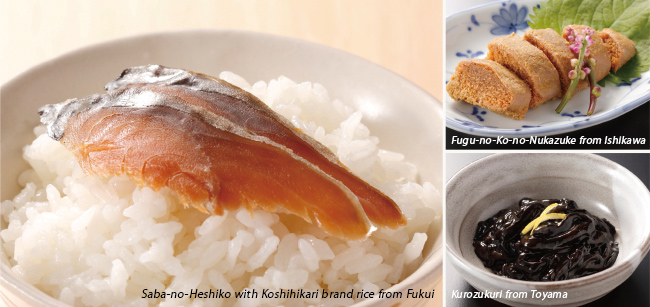
Part 1. Traditional fermented foods
Eating is believing
Hokuriku offers a rich variety of enjoyable foods from abundant seafood to indigenous vegetables and local specialty foods. The key point that makes Hokuriku food different from that of other regions is the "fermented foods" that are appreciated by connoisseurs. In fact, Hokuriku is often called the "Land of Fermented Foods." The wide variety of fermented foods, especially those of seafood, is literally unmatched. Let us now take you to the world of Hokuriku's local fermented specialties that are ideal to go together with your cupful of sake or bowlful of rice.
Fermented fish
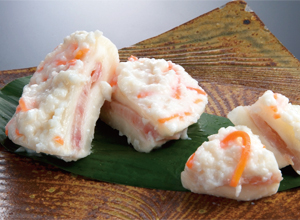
Kabura-zushi, a typical winter delicacy in Ishikawa and Toyama
All three prefectures of Hokuriku face the sea. Catching fresh fish is a daily affair. Today, we enjoy Kitokito fish (Toyama dialect meaning "fresh and vibrant") thanks to the advancement of modern refrigeration, freezing and logistics technologies. In the past, however, preservation was a big challenge.
Fermentation was the answer that our ancestors in Hokuriku found to this problem.
Fermentation is a technique that humans have used or have taken advantage of in connection with their dietary habits. The production of soya sauce and miso that are so well-loved by the Japanese people, as well as cheese and a variety of alcoholic beverages involve the fermentation process. Vegetable pickles, also made by the fermentation process, are found everywhere in Japan, but fermented fish are something rather unique to Hokuriku. They are indeed the "Ultimate Delicacy of Hokuriku" that is produced through the fine combination of quality raw materials, the master techniques of the people who make them and time-honored expertise in preserving food.
Optimal climate for fermentation
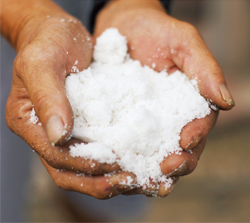
This salt was made the traditional way in a saltern in the region of Okunoto
Why have fermented food products developed so well in Hokuriku? The major reasons are an optimal environment, abundant raw materials and the temperament of the people. It snows rather heavily and the snow stays on the ground for many days. This hard winter is favorable for food fermentation because of the constant low temperature. Hokuriku shores have been rich grounds for fishing for centuries and something had to be done to take advantage of the abundant catch. Rice cultivation has been widespread, meaning that quality rice malt and rice bran are easily available. Another essential ingredient, salt, was also in abundance. There used to be many salterns until they disappeared in the face of more cost competitive imports. And most important is the temperament of the Hokuriku people. They are known for their perseverance. Our ancestors in Hokuriku must have developed these fermentation techniques through hard-work and a lot of trial and error.
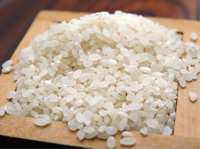
All three prefectures of Hokuriku produce quality rice, many of which are famous brands
Fermented specialties of Hokuriku thus prepared were presented to the imperial court and the shogunate, where they were appreciated as rare first-rate delicacies. The fermented food also served as a precious source of protein to villagers living in remote mountain areas; precious because Buddhism prohibited eating meat from "anything that walks on four legs." Fishermen traded for daily necessities and other items. For the people of Hokuriku, fermented food is an inseparable part of their life. Today, you can have the luxury of enjoying such a precious food.
There are many different types of fermented foods. In terms of the raw materials, they can be grouped into three types: (i) rice malt or rice-based, (ii) rice bran paste-based, and (iii) saltbased. The three prefectures of Hokuriku line up side by side, and so they have some fermented foods in common and some others that are local.
Rice malt-based fermented food that combines sweetness and richness
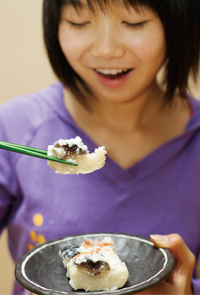
Daikon-zushi is a popular homemade sushi
One of the best-known rice malt-based fermented foods is Kabura-zushi. It is sometimes called a local food of Ishikawa Prefecture, but it is also made in a region of Toyama Prefecture. It is a kind of Nare-zushi (rice malt-fermented fish and rice), which is said to be the original form of today's sushi. To make Kabura-zushi, turnip is soaked in salt, cut into chunks, and cuts are then made to the turnip chunks. Slices of salted fish are placed into the cuts and they are soaked in rice malt for about one week. Amberjack is the most popular fish for Kabura-zushi in Ishikawa, while salmon and mackerel are also used in Toyama. Kabura-zushi can be prepared only in the wintertime and is almost a must for the auspicious occasion of New Year holidays. Some who try it for the first time are shocked by the appearance because the sushi is served with rice malt on it (not rinsed off). Once they try it, however, they are drawn into the richness and sourness of the rice malt, the crunchy turnip and the mouthful of umami that the fish produces, all coming together in perfect combination.
The origin of Kabura-zushi is not clear. Some say that in old times amberjack was a luxury only the samurai class was allowed to enjoy, and so the common people in town made Kabura-zushi to hide the fish meat in the cuts of the turnip. Similar to Kabura-zushi is Daikon-zushi which features radish and pickled dried herring. This was more common for common-class people. Both were made at home in former times, but today they are commercially produced by vegetable pickles makers and others and are readily available at department stores and specialty food shops. Some traditional restaurants and sake pubs also serve these local specialties. Come to Hokuriku and enjoy the local delicacies where they are prepared.
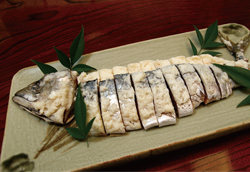
Saba-no-Nare-zushi is a rice bran paste-based pickled mackerel from Obama City, Fukui
Besides Kabura-zushi, Hokuriku offers many other varieties of Nare-zushi. While they may look almost the same and are prepared in almost the same way, each of the three Hokuriku prefectures has its own Nare-zushi using different fish species etc. For instance, the Daimon district of Imizu City, Toyama is famous for its Ayu-zushi (ayu sweet fish), the former Notomachi area of Notocho Town, Ishikawa is known for its Ajino- Susu (horse mackerel), and Saba-no-Nare-zushi (mackerel) is prepared in the winter in Fukui and in the summer in Toyama. They should all surprise you with a savor that mixes the flavor of matured fish umami and the richness of rice malt. They are not available all year round, but are well worth looking for.
A whole fish pickled in rice bran paste is an exquisite specialty
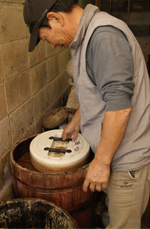
Some fermented foods require several years to mature
Now, let us introduce to you fermented foods prepared with rice bran paste. Non-sliced pickled fish soaked in rice bran paste may appear somewhat "weird" at first look. Some stores sell the pickled fish one by one out of pails filled with rice bran paste. Put it in your mouth to reveal a flavor you can't find anywhere else. The taste is rather "strong and lasting" (meaning "salty" in the Ishikawa dialect). It goes very well with a bowl of steamed rice or a cup of sake. It can be eaten in different ways. Some prefer eating it just by cutting it into slices with no further treatment. Others like to warm it up over a charcoal fire. The rice bran can be either rinsed off or eaten together with the fish. Find out your preferred style by trying out all of the possibilities. It can even be used as an ingredient in Western dishes, like as a substitute for anchovy. And what is good about this fermented food is its long life. You can buy it all year around. The preparation method is essentially the same for all kinds of fish. First, the fish guts and head are removed and the fish body is washed. Then, it is salted and is left to "rest" for six months to one year in a bed of rice bran paste seasoned by hot peppers and other "secret ingredients."
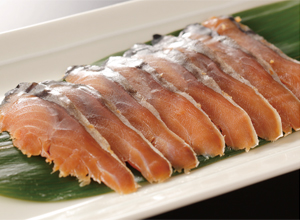
Sake lovers find it difficult to refuse Saba-no-Heshiko
Rice bran pickled fish is called different things in the three Hokuriku prefectures. It is called Heshiko in Fukui, and either Konka-zuke or Nuka-zuke in Ishikawa and Toyama. The fish also varies widely. The most representative may be the Saba-no-Heshiko (mackerel) for which the Wakasa region of Fukui Prefecture enjoys national fame. The mackerel head is not chopped off and the whole fish is soaked in rice bran paste. Large ones are over 30 centimeters in length. This product is available in department stores, local specialty stores and even at highway rest area shops. You may want to buy a whole or a half fish pack. Perhaps first you might try a rice ball with pieces of Heshiko inside.
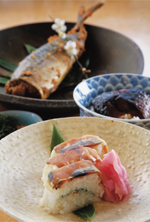
Heshiko is also good if made into an Oshi-zushi (pressed sushi)
Famous in Ishikawa and Toyama is Konka-Iwashi (pickled sardine in rice bran paste). It is reasonably priced and is enjoyed as a fermented food by everybody. Locals in the Noto region of Ishikawa Prefecture prepare a Bega-nabe pot dish, cooking Konka-Iwashi with vegetables and mushrooms in a stew of sake lees. People who live at the foot of Mt. Hakusan in Ishikawa Prefecture enjoy a winter pot dish called Ijiiji-nabe, stewing vegetable pickles with Konka-Iwashi. The fermented fish was a precious source of protein when the sea got rough or among the villagers in remote mountain areas.
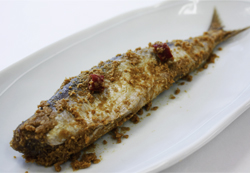
Konka-Iwashi sold with rice bran paste on it
Salt produces delicacies and seasonal dishes
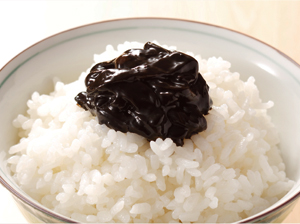
Kurozukuri literally means black
And we cannot forget salt, the most basic material for preserved foods. The rice malt- and rice bran paste-based pickles we mentioned above are prepared, as a first step, by salting the raw material.
The best-known fermented food based on salt is Shiokara (heavily salted, fermented viscera of marine animals). Shiokara made of squid viscera is the most Chapter III Culinary quest in Hokuriku Enjoy your first experience with Hokuriku food to the fullest extent Konka-Iwashi sold with rice bran paste on it Heshiko is also good if made into an Oshi-zushi (pressed sushi) Sake lovers find it difficult to refuse Saba-no-Heshiko 22 Hokuriku Tales vol.3 common. There is no squid fishing town in Japan that does not produce squid Shiokara. Toyama, however, has produced a rather unique squid Shiokara called Kurozukuri.
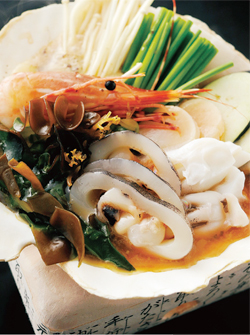
Ishiru-no-Kai-yaki is a blessing from the natural beauty of Noto
As the name suggests ("kuro" means black), it is a black Shiokara because it has squid sepia in it. It is prepared more or less in the same manner as standard squid Shiokara. Pretreated squid skin (meat) and viscera are mixed with sepia, and the mixture is left to ferment for about a week. The squid sepia contains umami components such as glutamic acid and amino acid. Accordingly, Kurozumi provides a more profound richness than common squid Shiokara, which attracts a number of Kurozumi enthusiasts. One bite, and you will be able to feel the gorgeous flavor of fully-matured umami fill your mouth, from quality squid. Watch out, it is "addictive." The natural wealth of the Japan Sea and the wisdom of our ancestors have worked together to bring about this blessing.
Another fermented food that has the honorable reputation as one of the three exquisite delicacies of Japan is Konowata, the salted intestines of sea cucumber. Nanao Bay on the Noto Peninsula in Ishikawa hosts a good number of sea cucumbers and the area is famous for Konowata production. The intestines of sea cucumbers that are caught in winter are taken out carefully. They are washed thoroughly until the sand is removed and are then salted and left to ferment for about one week. Konowata thus produced is a mouth-watering delicacy for sake lovers, as the salty air of the sea that brings Konowata lures them to ask for another cup.
And that's not all. Gyosho (fish sauce) is a seasoning made by the fermentation of fish. While you may have heard of Shottsuru from Akita and NAMPLA from Thailand, the fish sauce Hokuriku is proud of is Ishiri from Noto. Squid guts or fish such as sardine or mackerel are salted and are left to ferment for about nine months to make the sauce. The local people tend to call it Ishiri or Ishiru if squid guts are used and Yoshiru if fish is the raw material, but the distinction is not necessarily clear. According to a study, the umami components contained in Ishiri are twice as strong as those of standard soya sauce. Ishiri adds a deep taste to dishes. One typical dish for which Ishiri is famous is Ishiru-no-Kaiyaki (shell baked with Ishiru sauce), that is, fish and other seafood placed on a large seashell with mushrooms and cooked over an open fire. Ishiri is however not reserved to such local fancy dishes. Many people use it in their normal meals of curry rice or fried rice. More recently, some use it in the cooking of Italian or French foods. Its uses are unlimited.
Blowfish ovaries, an amazing food that detoxifies

Fugu-no-Ko-no-Nukazuke is still made the traditional way
Ovaries with roes are toxic organs in blowfish, but you can enjoy them thanks to the magic of fermentation here in Hokuriku. In fact, Fugu-no-Ko-no-Nukazuke (rice bran paste-based salted blowfish roe) has almost no parallel among the fermented foods of the entire world. It is the ultimate fermented food involving salt, rice bran paste and Ishiri all at work together. Microorganisms are considered to detoxify the blowfish organ in the course of fermentation, although the detoxification mechanism has not been clearly understood. This delicacy is given a special status under the national regulations on eating blowfish. Only licensed producers in Ishikawa are allowed to make it, and it is indeed laborious and time-consuming work. First the ovaries with roe are soaked in concentrated salt water (concentration is 35 to 40% or about ten times as thick as sea water) for a period of one year. Then they are washed and placed inside a pail filled with rice bran paste. Avoiding contact with air, they are left for more than another year, with the gentle pouring of Ishiru along the edge of the pail once in a while. After no toxicity is discovered through scientific testing, the product is shipped and served in slices with or without heating. It is extremely salty and should be enjoyed little by little with a sip of sake in between. It is also good with steamed rice. Today, it is available vacuumpacked and hence all year round. Many sake pubs have it. Please give it a try.
Hokuriku, a paradise for lovers of fermented food
Speaking about sushi, Masu-no-sushi (trout sushi) from Toyama is nationally famous. Many believe that this sushi was originally a Nare-zushi (fermented sushi) of trout and rice and was changed to the contemporary Hayazushi style (vinegaradded but unfermented fast-food version) during the Edo Period (differing views exist). There are enough Masu-no-sushi producers in Toyama to form a cooperative. The taste varies from one to another. You may want to try more than one to make a comparison. You may also want to imagine how it tasted in the years back when it was a fermented sushi.
Last but not least, we should not forget that sake is also a child of fermentation. Hokuriku is blessed with cold winters, moderate humidity and abundant quality water, the three essential requirements to produce good sake. Each brewery is proud of its unique taste, and you have a large variety of brands to choose from. Sake pubs and traditional restaurants have a stock of many local brands. We hope you will try as many as possible.
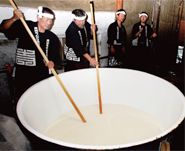
Hokuriku master brewers know how to make good sake
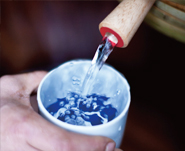
Every sake brewery has its own unique taste
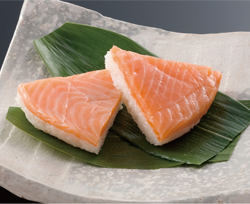
Masu-no-sushi, presumably fermented in old days
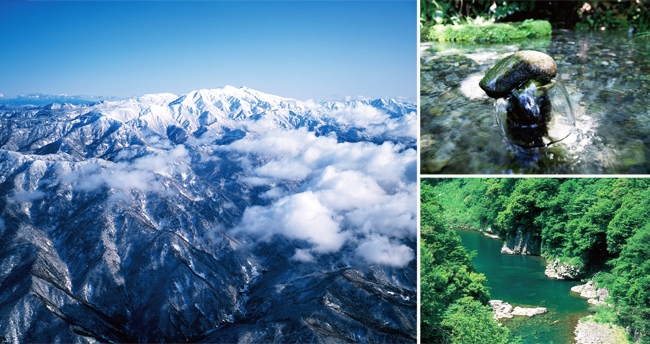 (left) Mt. Hakusan has been admired as a god of water since old days
(left) Mt. Hakusan has been admired as a god of water since old days
(top right) The water fountain of the Zemmeiji Temple springs out of a subsoil stream of the Kurobe River (Ikuji district of Kurobe City)
(bottom right) Early summer in the Gorge of the Kuzuryu River, which originates in Mt. Hakusan
Part 2. Snow-mountain water:
quality water makes quality foods
The deep snow that falls over Tateyama, Hakusan and the other high mountains of Hokuriku melts and forms river streams and subsoil water that nourish the villages and towns. The subsoil water absorbs minute quantities of minerals, which make it ideal for making good sake and for preparing delicious foods and dishes. The geographical advantage of Hokuriku, from the perspective of good quality water, is the presence of many rapid currents and alluvial fans. Let us now explore the close relationship between the good water and delicious foods of Hokuriku.
[Toyama] The quality water makes the rustic sweet so tasty
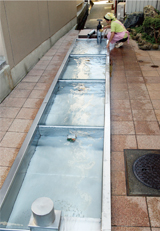
Shozu at Shimizuan was reportedly named by the haiku poet Matsuo Basho
This is the Ikuji district of Kurobe City in Toyama. The old port town has many fountains of water that come from the subsoil streams of the Kurobe River. In the Ikuji district alone, there are 20 such fountains that bear the local name of Shozu. In addition, many families have water wells dug in their yards and some of them have declined to be connected to the city's public water works.
Surprisingly enough, each fountain water tastes different. According to Ms. Kiyomi Komeya, an official Ikuji town walking guide, many local residents can tell which fountain the water is from if the test samples are all kept at the same temperature, say, 11 degrees Celsius. "Everybody of course claims his/her Shozu is the best. I know of no other communities that are so deeply committed to the taste of water as ours," she says.
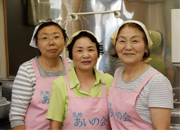
Members of Ikuji Ai-no-kai. From left: Ms. Yoshimi Noto, Ms. Kiyomi Komeya, and Ms. Sachiko Noto
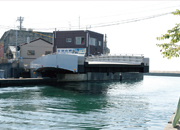
Ikuji Nakabashi, close to the Yasumi-dokoro Ai, is a swing bridge, rather uncommon in Japan, to allow ships to come into and leave the port.
A popular food that takes advantage of the tasty water is Mizu-dango (rice dumpling). Rice powder and potato starch are mixed in hot water, kneaded, steamed and pounded. The cake thus prepared is made into a stick-like shape, cut to bite size, cooled in cold water and served covered in Kinako soybean flour. This sweet is simple and rustic but the water used in making it is entirely from Ikuji.
Mizu-dango is served, among other things, at the "Yasumi-dokoro Ai," a rest house run by a community revitalization volunteer group named Ikuji Ai-no-kai, of which Ms. Komeya is a member. Eating rice dumpling sweets has been an old tradition in the area; the community maternity hospital serves what is called Mikka-dango (literally, three days of rice dumpling sweets) in the belief that the dumpling helps the mother to produce enough milk to feed the baby.
The smiling faces of the Ikuji Ai-no-kai members that shine as fresh as the water of Ikuji are drawing an increasing number of visitors and repeaters to "Ikuji, the town of Shozu."
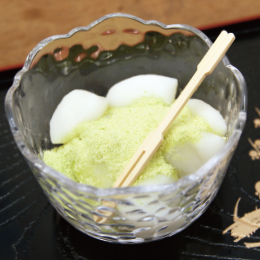
Mizu-dango sweets (100 yen)
Only served in June through September
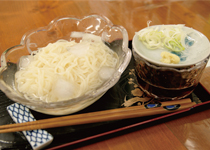
Yasumi-dokoro Ai is open on Saturdays (closed in December through March). Hosouchi-men noodle (200 yen). The volunteer group" does not seek profit" but what a bargain price. Only served in June through September
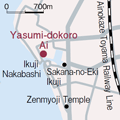
Yasumi-dokoro Ai
TEL:090-8263-3781

[Ishikawa] A dish that knows no parallel, blessed by the indigenous materials nurtured by the subsoil water of Mt. Hakusan
The Hakusan mountain range supplies water to a vast area of Central Japan, north and westward to the Japan Sea through the Tedori River (Ishikawa), the Kuzuryu River (Fukui) and the Shogawa River (Toyama), and southward to the Pacific Ocean through the Nagara River (Gifu and other prefectures). It is no wonder that Mt. Hakusan has been worshipped as a god of water over centuries.
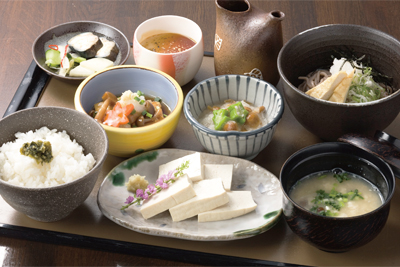
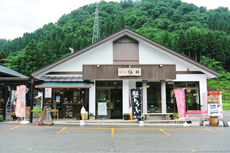
(left) Denko is next to the Michi-no-Eki (highway rest station)" Sena"
(right) The Tofu-zen (1,400 yen) plate menu includes: solid tofu sashimi, soba noodles with grilled Aburaage fried tofu on top, miso soup with Oboro-tofu and seasonal side dishes.
The three mountain villages of Gokayama (Toyama), Shirakawago (Gifu) and akusanroku (Ishikawa) have joined hands to promote a local dish campaign named "Hakusan Hyakuzen" (Hundred Dishes of Hakusan). Each one of the participating restaurants has developed a creative plate menu that utilizes a variety of local foods nurtured by the tasty water from Mt. Hakusan. As of April 2018, membership included 38 restaurants with 75 dishes. Here, let's visit one of them, Denko, which serves home-made tofu dishes.
This restaurant makes its own tofu using the subsoil water from Mt. Hakusan. Tofu in this region is Kata-tofu, a heavy-weight and very firm tofu. It has a texture and flavor that no silken or cotton tofu can match. As the proverb goes, water is a life and death issue in making tofu. A huge quantity of water is used to hand make tofu and the tofu quality depends very much on the water quality. "When I came to this place as a young bride, the taste of the water caught me by surprise. I could make soup stock so easily, and cooked rice was so good, and miso soup too. Everything I cooked with water tasted so delicious. I strongly suggest that you try the firm tofu sashimi first, without any seasoning. The subtle sweetness and the natural flavor of soybeans will fill your mouth. This feeling is something you do not experience with ordinary tofu made with ordinary water," says Ms. Harue Deguchi, the Okami (madam maitre d'hôtel) of Restaurant Denko.
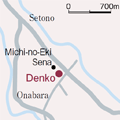
Denko
TEL:076-256-7325
The tofu making is done by her husband, Mr. Hiroshi Deguchi. He keeps select round soybeans soaked in water for over 30 hours to soften them, then steams and squeezes them under pressure. Then he sprays natural magnesium chloride to harden them slowly. The dish is a result of unsparing and time-consuming hard work, and a commitment to quality materials.
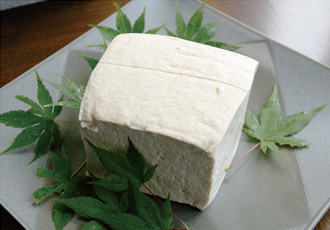
Denko's very firm tofu is not so hard and has a creamy texture.
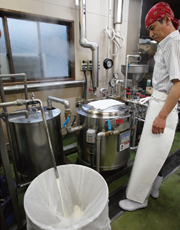
Select soybeans are steamed and squeezed
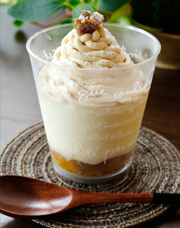
The sweet "Tofu Mont Blanc", in which the naturalblessings of the mountainare condensed (410 yen)
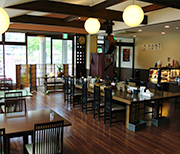
The restaurant's spacious interior
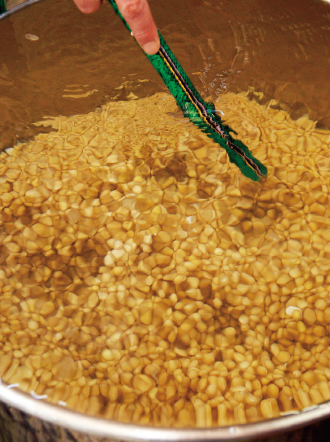
Subsoil water is used to wash the soybeans
[Fukui] The quality water gives birth to a home-made soba noodle restaurant

Oshozu-Fudoson water
The Fukui Prefecture government has put into place the "Tasty Fukui Water" certification system for drinkable spring water. There were 35 such certified water sources as of July 2018, many of which are managed and maintained by the people in local communities. Their affection to the fountain water, their belief in sanctified water and their pride have preserved these fountains to this date.
The central part of Echizen City (JR station Takefu and its environs) has many fountains because it sits on the alluvial fan of the Hino River that flows down to the basin on and under the ground. One of the most famous fountains is Oshozu- Fudoson-no-Mizu. It is located in the city center and the water comes out continuously from a faucet shaped as the mouth of a dragon by the temple hall which is dedicated to Fudo-Myo-o (Acala deity). Some 50 to 60 people in the neighborhood visit the fountain to fetch water every day.
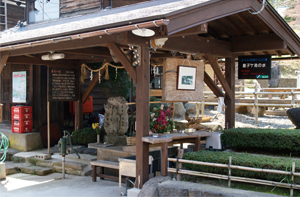
Ojiga-ike is one of the certified sources of" Tasty Fukui Water". It is very close to Kakyo Park in the Imadate district of Echizen City. The spot is well maintained as a small history museum.
Across the street from the Oshozu-Fudoson-no-Mizu is a soba noodle shop named Soba-seki Oshozu-an, which serves home-made soba known as "nine-to-one" soba because 9 parts of 100% Fukui-grown soba flour is mixed with 1 part of binder wheat flour. The water that is used to help knead the flour mix, to boil the noodles, to cool and rinse the boiled noodles and to prepare the dipping sauce is all from the Oshozu- Fudoson fountain. Mr. Yukio Shimbo, owner chef of the restaurant, used to make soba as a hobby. So many people liked his soba that he opened the restaurant in 1998 at this place, which used to be a rest spot in the shopping street. "As long as the flour and water are good, anyone can make good soba. I would not have decided to open this soba restaurant if I had not been able to use this water," explains Mr. Shimbo.
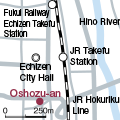
Oshozu-an
TEL:0778-21-5088
The difference that the water makes can be best understood from the sobayu (the water in which soba noodles were boiled). It has a very light char-like savor. Mr. Shimbo recommends, "Please test it yourself by drinking it without adding the sauce to the sobayu as you would normally do."
In the districts of Takefu and Imadate, Echizen City, there are many famous soba restaurants. The availability of good water must be the reason.
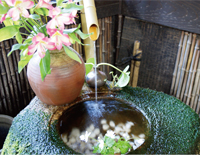
Fountain water is taken into the restaurant
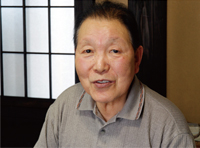
Mr. Yukio Shimbo
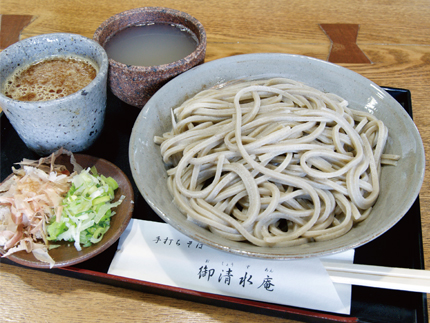
The Oroshi soba (cold soba with grated radish; 600 yen) of Oshozu-an runs down the throat smoothly, yet has a firm texture.
For further information:
- Kurobe City / Commerce and Tourism Section
TEL: 0765-54-2111 - Hakusan City (Hakusan Hyakuzen) / Hakusan City Tourist Inform ation Center
TEL: 076-273-4851 - Echizen City / Echizen City Tourism and Master 's Work Information Desk
TEL: 0778-24-0655
It is only natural that Hokuriku has so many delicious foods because Hokuriku is blessed with abundant good quality water.
